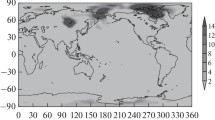Summary
The role of the condensation nuclei in the atmospheric electrical processes becomes especially evident if it is imagined how this process would take place without condensation nuclei: On the entire earth only the global atmospheric electrical phenomena would become effective, while the relations to the weather processes would not exist. Thus, the influence of the weather on the electric processes is causally related with the existence of suspensions, resp. condensation nuclei.
The atmospheric electrical processes are to be interpreted from the co-operation of generators and variabile circuit elements. In both groups the condensation nuclei play an important part as is shown here in detail:
The known relations between the atmospheric electrical potential gradient and the atmospheric conductivity on one hand and meteorological elements [air masses, turbulence, exchange (Austausch), inversions, etc.] on the other hand must be understood by the recombination relations between small ions and suspensions. They belong to the group of variable circuit elements.
As an effect observed in recent years (increase of the potential gradientand the air-earth-current after sunrise) which, corresponding to its behaviour varying at the different seasons and from place to place, must be interpreted as exchange (Austausch) effect («Austausch-Generator»), the co-operation of condensation nuclei is demonstrated on the basis of comprehensive investigations at some stations of the Swiss Alps. This seems to exist in the fact that space charge formations in the atmosphere may be transfered into a more stable, longer lasting state by the interaction of the condensation nuclei to a greater or smaller extent so that the transport of these charges by nonelectric forces necessary for the generator effect is quantitatively influenced by the number of nuclei.
Zusammenfassung
Die Rolle der Kondensationskerne im atmosphärischen Geschehen wird besonders deutlich, wenn man sich vorstellt, wie sich dieses Geschehen ohne Kondensationskerne abspielen würde: Es käme dann auf der ganzen Erde nur der globale Anteil der atmosphärisch-elektrischen Erscheinungen zur Geltung während die Bindungen zum Wettergeschehen fehlen würden. Somit hängt also der gestaltende Einfluß des Wetters auf die elektrischen Vorgänge ursächlich mit dem Vorhandensein von Suspensionen bezw. Kondensationskernen zusammen.
Die atmosphärisch-elektrischen Ereignisse sind zu verstehen aus dem Zusammenwirken von Generatoren und veränderlichen Schaltelementen. In beiden Gruppen spielen die Kondensationskerne eine entscheidende Rolle, wie im einzelnen gezeigt wird:
Die bekannten Zusammenhänge zwischen dem luftelektrischen Potentialgefälle und der atmosphärischen Leitfähigkeit einerseits und meteorologischen Elementen (Luftkörper, Turbulenz, Austausch, Inversionen u.a.) andererseits sind aus den Wiedervereinigungsbeziehungen zwischen Kleinionen und Suspensionen zu verstehen. Sie gehören in die Gruppe der veränderlichen Schaltelemente.
An einem in den letzten Jahren beobachteten Effekt (Anstieg von Potentialgefälle und Vertikalstrom nach Sonnenaufgang), der seinem jahreszeitlich verschiedenen und von Ort zu Ort wechselnden Verhalten entsprechend als Austauschwirkung zu deuten ist («Austausch-Generator»), wird nach umfangreichen Untersuchungen an einigen Stationen der Schweizer Alpen die Mitwirkung der Kondensationskerne demonstriert. Diese scheint darin zu bestehen, daß Raumladungsbildungen in der Atmosphäre je nach dem Vorhandensein von Kondensationskernen in stärkerem oder geringerem Maße gewissermaßen zeitlich fixiert werden, sodaß der zur Generatorwirkung notwendige Transport dieser Ladungen durch Kräfte nicht-elektrischer Natur quantitativ durch die Kernzahl beeinflußt wird.
Similar content being viewed by others
Literaturhinweise
H. Landsberg:Atmospheric Condensation Nuclei. Ergebnisse der kosmischen Physik, Bd. 3, S. 155–255 (1938).
H. P. Berlage Jr.:Ueber einen Fall, in dem ein Frontdurchgang mit einer Aenderung des elektrischen Feldes verknüpft ist. Naturkund. Tijdschr. v. Nederlands-Indien, 97, 59–60 (1937).
H. Israël:Die Unruhe des luftelektrischen Feldes (Beispiele für den Witterungseinfluss auf das Feldverhalten am Boden). Met. Zeitschr., 60, 56–62 (1943).
F. Rossmann:Luftelektrische Messungen mittels Segelflugzeugen. Berichte des Dt. Wetterdienstes in der US-Zone, Band 3, Nr. 15, 54 S. (1950).
C. Nordmann:Diverses recherches relatives au magnétisme terrestre, à l'ionization atmosphérique et au champ électrique de la terre effectuées notamment à l'occasion de l'éclipse de soleil totale du 30 août 1905. Annales du Bureau des Longitudes 8, D3-D60, Paris 1911.
H. Israël:Gedanken und Vorschläge zur luftelektrischen Arbeit. Wiss. Abhandlungen. Reichsamt f. Wetterd. V, N. 12, 26 S. (1939).
C. G. Stergis:Study of Atmospheric ions in a Nonequilibrium System. Geophys. Res. Papers, Cambridge Res. Center, Nr. 26, April 1954; S.a.: Journal of Geophys. Res., 59, Nr. 1 (1954).
R. E. Holzer:Studies of the Universal Aspect of Atmospheric Electricity. Final Report zu Contract N. AF 19 ((122)-254, Los Angeles, 55 S. (1955).
H. W. Kasemir:Der Austauschgenerator. Arch. f. Met., Geophys. u. Bioklim (A) 9, 357–370 (1956)
F. J. W. Whipple:On Potential Gradient and the Air-Earth-Current. Terr. Magn. 37, 355 ff. (1932).
H. Lettau:Anwendung neuerer Ergebnisse der Austauschlehre auf zwei luftelektrische Fragen. Gerlands Beitr. z. Geophys., 57, 365–383 (1941).
H. Israël:Bericht über die Arbeitstagung «Luftelektrizität im AGJ» am 11./12.5.1956 in Aachen. (In Vorbereitung).
H. Israël:Die halbtägige Welle des luftelektrischen Potentialgefälles. Archiv f. Meteorologie, Geophys. u. Bioklimatologie, 1, 247–251 (1948).
O. Haxel &G. Schumann:Selbstreinigung der Atmosphäre, Zs. Physik, 142, 127–132, 1955.
H. Israël:Synoptical Research in the Field of Atmospheric Electricity. Proceedings of the Conference on Atmospheric Electricity at Portsmouth, N.H., May 19–21, 1954. Cambridge/Mass. 1956.
Author information
Authors and Affiliations
Rights and permissions
About this article
Cite this article
Israël, H. Kondensationskerne im Rahmen der Luftelektrizität. Geofisica Pura e Applicata 36, 182–200 (1957). https://doi.org/10.1007/BF01993007
Issue Date:
DOI: https://doi.org/10.1007/BF01993007




